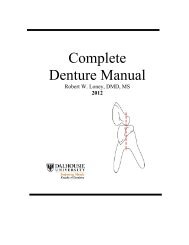RPD Manual 11 - Removable Prosthodontics - Dalhousie University
RPD Manual 11 - Removable Prosthodontics - Dalhousie University
RPD Manual 11 - Removable Prosthodontics - Dalhousie University
Create successful ePaper yourself
Turn your PDF publications into a flip-book with our unique Google optimized e-Paper software.
Major Connectors - 32<br />
Definition<br />
Major Connectors<br />
The unit of a removable partial denture that connects the various parts of the denture. Its<br />
principal functions are to provide unification and rigidity to the denture.<br />
Functions of a Major Connector<br />
1. Unification<br />
A major connector units all other components of a partial denture so that the partial denture<br />
acts as one unit.<br />
2. Stress Distribution<br />
By unifying all elements of a partial denture the major connector can distribute functional<br />
loads to all abutment teeth, so that no one abutment is subjected to extreme loading.<br />
Unification of the direct retainers with the denture bases aids in distributing forces between<br />
both the teeth and the mucosa. This is particularly important in Class I and II partial<br />
dentures. In some maxillary cases a major connector with broad palatal contact is selected.<br />
In these situations the broad base offers additional support, distributing stress over a larger<br />
area.<br />
3. Cross-Arch Stabilization (Counterleverage)<br />
By uniting one side of the arch to the other bracing elements on one side of the arch can aid<br />
in providing stability to the other. This can aid in dissipating twisting and torquing forces.<br />
Requirements of a Major Connector<br />
1. Rigidity<br />
Rigidity is necessary to ensure that the partial denture functions as one unit. If the denture<br />
flexes, stress distribution and cross arch stabilization can be compromised since different<br />
portions of the denture can move independent of the others. A major connector can be<br />
made more rigid by:<br />
a. using a more rigid alloy (Chrome-cobalt > gold alloys; cast > wrought metal)<br />
b. using a 1/2 round or 1/2 pear shaped bars (more rigid than flat bars)<br />
c. increasing the bulk as the length increases<br />
d. corrugating linguo-plate or rugae areas.<br />
2. Non-Interference with the Soft Tissues<br />
Major connectors should not enter into undercut areas unless tissue impingement can be<br />
avoided by changing the selected path of insertion or by using minor undercut blockout. In<br />
addition, connectors should not end on the crest of rugae or at the free gingival margin. If<br />
terminated in these areas, it is possible that movement of the connector could cause tissue















